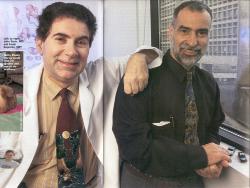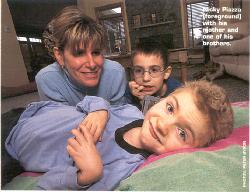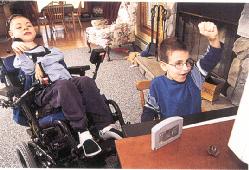Dr. John Bach "Inspires" Patients to Survive and Thrive
An Inspirational Story by Mary Ann Littell
Reprinted from UMDNJ HealthState Summer 2002, used by permission.

|
A Matter of Life and Breath
Dr. John Bach "Inspires" Patients to Survive and Thrive An Inspirational Story by Mary Ann Littell Reprinted from UMDNJ HealthState Summer 2002, used by permission. |

|

Meet Nicky Piazza. In many ways, he's a typical eight year old. When he's not in school, he hangs out at home, watching TV or playing video and computer games with his two younger brothers. He enjoys playing with his dog Bailey and going on family vacations to the beach.
In other ways, however, Nicky is not so typical. He rides a bus to school--but it's a minibus that's specially equipped to accommodate his motorized wheelchair. When his classmates go to lunch, he has physical therapy. He doesn't eat lunch (or any meals, for that matter) but gets nourishment through his "mickey button," a gastric tube in his abdomen. And coming down with a cold is not a minor event for him--in fact, it can be deadly.
When Nicky was seven months old, he was diagnosed with Werdnig-Hoffmann disease, or spinal muscular atrophy (SMA) type 1. This rare neuromuscular disorder affects one in 5,000 and is categorized into five types, with type 1 being the most severe. One in 40 adults carries the defective gene for SMA. For a child to inherit the disorder, both parents must be carriers and transmit the gene to the child. SMA is generally diagnosed at birth (those affected are called "floppy newborns" because they lack muscle tone) or in early infancy.
Other neuromuscular diseases affect all age groups and are usually inherited. They include Duchenne muscular dystrophy (DMD), Becker muscular dystrophy, Lou Gehrig's disease or amyotrophic lateral sclerosis (ALS), and myasthenia gravis, to name a few. While these disorders are very different, they share a common trait: They cause weakness of all muscle groups, including those that control limbs, swallowing and breathing.
While muscle weakness significantly affects overall health and mobility, the most serious consequences are respiratory complications. "Breathing and especially coughing muscle weakness is the major cause of repeated hospitalizations and death for people with neuromuscular disease," says John Bach, MD, professor and vice chair of the Department of Physical Medicine and Rehabilitation at UMDNJ-New Jersey Medical School. If a simple cold sets in, breathing and coughing become even more difficult and airway secretions build up. Too often, the end result is pneumonia and respiratory failure.

Rehabilitating patients with neuromuscular disease by improving breathing and coughing function has been the primary focus of Bach's career. As medical director of the Center for Noninvasive Mechanical Ventilation Alternatives and Pulmonary Rehabilitation at UMDNJ-University Hospital in Newark, he is internationally recognized for his innovative work in noninvasive (nonsurgical) mechanical ventilation. The author of 250 publications, including eight books, he has lectured in more than 30 countries around the world.
Bach speaks each year in Japan, and has a fascinating story to tell. He pops a CD into his office computer and sits back as a song fills the air. It's synthesized techno-music, produced on computers. The lyrics are in Japanese, the voices light and ethereal. Years ago, a Japanese physician, Dr. Tatara, attended a lecture by Bach and was so impressed that he established a residential facility for patients with neuromuscular disorders. The musicians who recorded the CD, young men in their 20s, are residents of Tatara's facility, and all have DMD. The name of their band is also DMD: Dream Music Directory. "The music is fabulous! I can't understand a word if it. But it's great!" Bach enthuses.
It's clear that what he's really thrilled about is the success of these young men with DMD. While they are wheelchair-bound and breathe with mechanical assistance around-the-clock, they are writing and recording music, and living productive lives, thanks to unique methods developed by Bach and his team at the Center.
Helping Nicky Breathe
Nicky Piazza is another patient who has benefited from Bach's therapy. "Doctors told us Nicky would not survive beyond 2, but we didn't believe it," says his mother Kathleen. In fact, he was relatively healthy until he turned 2. In November 1995, he came down with a simple cold that quickly grew worse. His lips turned blue from lack of oxygen. He was rushed to a local hospital and then airlifted to a large medical center.
Nicky was intubated, and a ventilator pumped air in and out of his tiny lungs. After a month in the hospital, he had improved, but the doctors were unable to extubate him. They had removed the tube from his mouth and left him to breathe on his own, but he could not. They re-intubated him but said there was little hope, and advised his parents to put a 'DNR' (do not resuscitate) order on his chart. Outraged, they refused.
The Piazzas were told their only hope was a tracheostomy for Nicky. A hole would be cut in his throat and a tube inserted. He'd be totally dependent on a ventilator and unable to speak. Adamantly against such drastic surgery, they checked their son out of the hospital, took him home, and arranged for nursing care.
At this point, Nicky had been extubated and was breathing with the aid of a BIPAP (bilevel positive airway pressure device), which delivers air under pressure via the nose or mouth. He pulled through, but his parents knew it was only a matter of time before he became sick again. Desperate for answers, Kathleen and her husband Manny searched the Internet for information about their son's condition.
They learned about Bach's innovative protocol from a New Jersey parent who has twins with SMA type 2. While the therapy sounded promising, they held off making an appointment. "We'd seen so many physicians, and none of them ever gave us any hope," Kathleen says. "Frankly, we were skeptical."
In spring 1996, Nicky got another cold and was hospitalized and intubated. Again, physicians were not able to extubate him, and told the parents he was failing and would most likely die. Kathleen recalls, "The doctors were ready to give up, but we weren't. We checked Nicky out of the hospital and took him by ambulance to University Hospital in Newark."
On Bach's protocol, he quickly improved. Ten days later, he went home. "This therapy was just what our son needed," says Kathleen.
Bach explains that in people with neuromuscular disorders, respiratory failure can develop suddenly. More than 85 percent of such episodes occur during chest colds. Because the respiratory muscles are too weak to ventilate the lungs or clear the airways of respiratory secretion, the person develops respiratory failure and pneumonia, and is hospitalized, intubated, and placed on a ventilator. "When extubation is not done properly, the way it is done in the Pediatric Intensive Care Unit at University Hospital (and only at University Hospital), the patient must undergo tracheostomy to permit extubation," says Bach. Having a tracheostomy tube greatly diminishes quality of life by resulting in continuous need for respiratory support and preventing speech in these patients.
In the first four years of Nicky's life, he was intubated and extubated more than 10 times during various hospital stays. However, after treatment and training at the Center, his breathing problems are well under control and he hasn't been to a hospital in four years. When he gets a cold, his parents know what to do to help him keep breathing and clear secretions.
Nicky, like many other patients with neuromuscular disorders, has in-home nursing assistance seven days a week. He has attended regular school since kindergarten and is now in the third grade, just like his 8-year-old peers. Awareness and intelligence are not affected by SMA, and he's very bright and articulate. Since the muscles that control speech are also affected, he has speech therapy a few times a week. He learns quickly and is easily understood. His parents are glad they refused to have the tracheostomy procedure.
"In general, virtually nobody who can speak should ever recieve a tracheostomy tube because of muscle weakness," says Bach. "And those who have them should consider having them removed." Physicians at the Center have in fact removed tracheostomy tubes from more than 1000 people who were dependent on respirators and trained them to breathe using noninvasive techniques.
Bach says that in the majority of cases, tracheostomies can be avoided. Studies of ventilator users who have used both tracheostomy and noninvasive methods of ventilatory support invariably prefer the latter. After five years, tracheostomies create many health complications, including serious infections. In fact, most tracheostomy patients eventually die of these complications. "Physicians are quick to suggest a tracheostomy because they think it's easier to manage the patient that way," he says. "They don't really understand the benefits of noninvasive methods or how to do them."
Giving Breaths, Saving Lives
The Center, which was established in 1992, is dedicated to the care of patients with neuromuscular disease and respiratory impairment from any cause. On staff are physicians from numerous specialties, including neurosciences, anesthesiology, surgery, and orthopedics, as well as respiratory therapists and speech-language pathologists. Some 60 percent of the Center's patients are children under the age of 18.
Bach contends that the majority of people with neuromuscular disorders are not managed optimally by physicians. While orthopedic problems are approached assertively, prevention of respiratory problems is given short shrift or ignored. "Families of people with neuromuscular disorders are usually told by doctors that they have three options," he says. "The first is to do nothing, or 'let nature take its course.' This ultimately results in death from respiratory failure. The second option is a tracheostomy, which makes a person completely dependent on a respirator and unable to speak. The third option, which is ours, is using noninvasive respiratory aids to facilitate breathing and coughing."
Using this third option, respiratory complications can be minimized and in many cases, avoided entirely, says the physician. His protocol utilizes close monitoring of oxygen and respiratory muscle function, noninvasive ventilation by nose or mouth as needed, and assisted coughing when necessary.
What is in Bach's powerful arsenal? A variety of devices and aids that are conceptually fairly simple. First, portable instruments such as spirometers and oximeters painlessly measure oxygen and respiration levels. When they are low, inspiratory muscle aids are used to enhance breathing. Air is administered through nose or mouth pieces or masks that are attached to ventilators. The procedure is called intermittent positive pressure ventilation, or IPPV. It is regular air, not pure oxygen, which can be harmful to those with muscle weakness (see box, above). Some people require supplemental air all the time, while others use it as needed--during a cold, for instance. Virtually everyone with neuromuscular disorders eventually requires aid for nighttime breathing, because respiratory levels drop even lower when a person is asleep.
Expiratory muscle aids involve use of manually and mechanically assisted coughing to eliminate airway secretions. The In-exsufflator, or CoughAssist, pulls air and mucus out of the lungs by applying positive pressure to the airway, and then rapidly shifting to negative pressure. This rapid shift of pressure produces a simulated cough. Bach says that even very young children can learn to cough with assistance. "Many people with DMD, SMA, ALS, and similar conditions should never require hospitalizations for breathing difficulties and can live decades longer than most people think," says Bach. Unfortunately, too many physicians think these disorders are untreatable.
Quality of Life Issues

Many people unfamiliar with these diseases may think that being wheelchair-bound and dependent on these respiratory aids offer a poor quality of life. Bach disagrees. "I treat a lot of children," he says. "Their parents love them as much as any parent loves a child. They should be the judges of their quality of life, not other people." With the help of computers and technology, his patients attend school, dress up for Halloween, surf the Web and hold jobs. One of Bach's patients with ALS is a municipal court judge who has been using a computer-activated communication system as well as an inspiratory muscle aid to facilitate breathing for 15 years.
An observer may wonder if Kathleen Piazza holds a mechanical engineering degree, so familiar is she with her son's equipment. It only seems that way. Respiratory therapists from the Center, like Brian Weaver, RRT, and Louis Saporito, RRT, train family members in the use of noninvasive ventilation alternatives. Saporito has been a member of Bach's team for 18 years, and they know each other so well that they finish each other's sentences. Saporito makes house calls, working with patients and families in their homes. "The equipment can be confusing at first, but it is not difficult to operate," he says. "I go in there and take them through it until they're comfortable." If there is in-home nursing care, he trains them too.
The house calls are not always local. Few physicians do what Bach does. So patients come from great distances for treatment and training. When they return home, they often need help in setting up in-home care. A few years ago, a set of twins from Georgia, both with SMA, same to the Center for treatment. When they flew back to Georgia, Brian Weaver went with them to help them set up their equipment at home. He also visited other healthcare personnel in the use of inspiratory aids. "Now the twins can get the care they need right in their hometown," he says. "And the protocol is in place to help other patients in Georgia."
It is the physician's goal to spread the word to all patients with neuromuscular disorders and their caregivers: "People can survive with neuromuscular disease, and they can live meaningful lives."
|
www.DoctorBach.com
Dr. Bach's Articles: ©2000-2004, John R. Bach, MD, used by permission.
|
You are welcome to print or email the articles on this website provided you reference "www.DoctorBach.com". For any other use, please contact Rich Clingman prior to use.